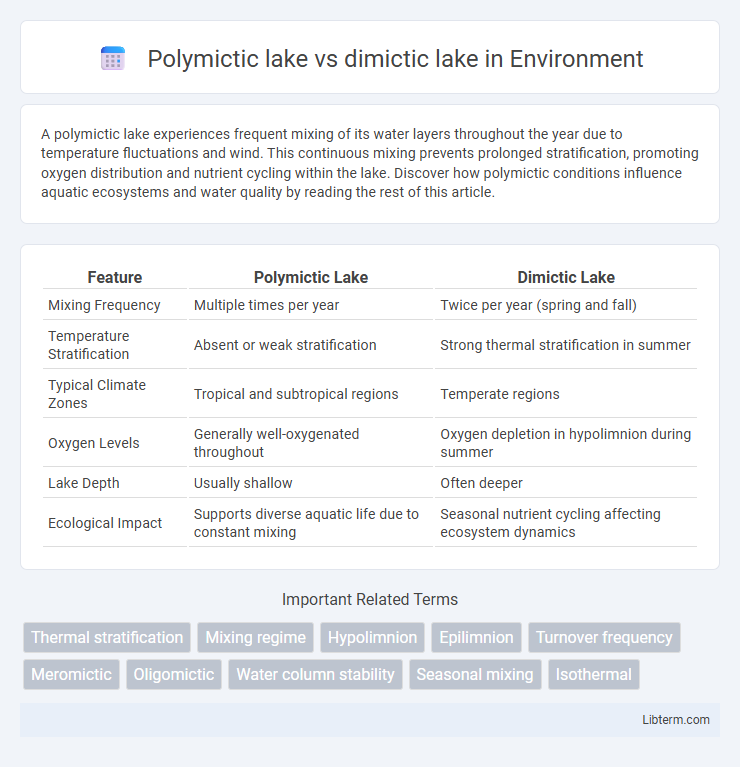A polymictic lake experiences frequent mixing of its water layers throughout the year due to temperature fluctuations and wind. This continuous mixing prevents prolonged stratification, promoting oxygen distribution and nutrient cycling within the lake. Discover how polymictic conditions influence aquatic ecosystems and water quality by reading the rest of this article.
Table of Comparison
| Feature | Polymictic Lake | Dimictic Lake |
|---|---|---|
| Mixing Frequency | Multiple times per year | Twice per year (spring and fall) |
| Temperature Stratification | Absent or weak stratification | Strong thermal stratification in summer |
| Typical Climate Zones | Tropical and subtropical regions | Temperate regions |
| Oxygen Levels | Generally well-oxygenated throughout | Oxygen depletion in hypolimnion during summer |
| Lake Depth | Usually shallow | Often deeper |
| Ecological Impact | Supports diverse aquatic life due to constant mixing | Seasonal nutrient cycling affecting ecosystem dynamics |
Introduction to Lake Mixing Regimes
Polymictic lakes experience frequent mixing throughout the year, usually because of shallow depths and high wind exposure, preventing long-lasting thermal stratification. Dimictic lakes undergo two distinct mixing periods annually, typically in spring and autumn, with thermal stratification developing in summer and winter. Understanding these mixing regimes reveals critical information about oxygen distribution, nutrient cycling, and aquatic ecosystem health.
What Is a Polymictic Lake?
A polymictic lake is characterized by frequent mixing of its water layers throughout the year, preventing thermal stratification commonly seen in dimictic lakes. Unlike dimictic lakes, which mix twice annually during spring and autumn, polymictic lakes experience continuous or multiple mixing events due to shallow depth and temperature fluctuations. This constant mixing influences oxygen distribution and nutrient cycling, often resulting in more uniform temperature and chemistry throughout the lake.
What Is a Dimictic Lake?
A dimictic lake experiences two mixing periods annually, typically in spring and fall, when surface water temperatures equalize with deeper layers, allowing complete turnover and oxygen redistribution. Unlike polymictic lakes, which mix frequently due to shallow depths and continuous temperature changes, dimictic lakes stratify strongly in summer and winter, creating distinct thermal layers. This seasonal stratification affects nutrient cycling and aquatic life by limiting oxygen supply to deeper zones during stratified periods.
Key Differences Between Polymictic and Dimictic Lakes
Polymictic lakes experience frequent mixing throughout the year due to continuous temperature fluctuations, preventing thermal stratification, whereas dimictic lakes undergo two distinct mixing periods annually, typically in spring and autumn, separated by stable stratification phases. Polymictic lakes are usually shallow and located in tropical or subtropical regions, facilitating constant circulation, while dimictic lakes are generally deeper and found in temperate climates where seasonal temperature changes drive stratification and turnover. These differences in mixing regimes significantly impact oxygen distribution, nutrient cycling, and aquatic ecosystem dynamics within each lake type.
Seasonal Mixing Patterns
Polymictic lakes experience frequent mixing throughout the year, often daily or multiple times during warmer seasons, due to shallow depths and minimal thermal stratification. Dimictic lakes undergo two distinct mixing events annually, typically in spring and autumn, as water temperatures converge, breaking down thermal layers formed in summer and winter stratification. The seasonal mixing patterns in these lakes significantly influence oxygen distribution, nutrient cycling, and aquatic ecosystem dynamics.
Effects on Water Temperature and Stratification
Polymictic lakes experience frequent mixing throughout the year, preventing stable thermal stratification and causing temperature profiles to remain relatively uniform. Dimictic lakes undergo two thermal turnovers annually, leading to distinct stratification periods with warmer epilimnion and cooler hypolimnion layers during summer and ice cover in winter. These differing mixing patterns directly impact oxygen distribution, nutrient cycling, and aquatic ecosystem dynamics.
Ecological Implications and Biodiversity
Polymictic lakes experience frequent mixing throughout the year, promoting uniform oxygen distribution and nutrient availability, which supports diverse aquatic ecosystems and resilient biodiversity. Dimictic lakes undergo two distinct mixing periods annually, leading to stratified conditions that create varied habitats and temperature gradients, fostering specialized species adapted to different layers. These differing thermal and oxygen regimes influence nutrient cycling, species composition, and overall ecological productivity in freshwater environments.
Geographic Distribution and Typical Climates
Polymictic lakes, commonly found in tropical and subtropical regions, experience frequent mixing due to constant temperature or wind-driven disturbances, often in low-latitude areas with warm climates. Dimictic lakes predominantly occur in temperate regions where seasonal temperature variations cause two distinct mixing periods annually, typically in areas with cold winters and warm summers. Geographic distribution reflects climate influence, as polymictic lakes are common in warmer zones like the Amazon basin, while dimictic lakes are widespread across North America and Europe where seasonal stratification occurs.
Impact on Water Quality and Management
Polymictic lakes undergo frequent mixing throughout the year, preventing prolonged stratification and reducing the risk of oxygen depletion in deeper waters, which improves water quality and simplifies aeration management. In contrast, dimictic lakes stratify twice yearly, creating distinct thermal layers that can lead to hypoxic conditions in the hypolimnion, requiring targeted monitoring and interventions like artificial mixing or oxygenation to maintain ecological balance. Effective water quality management depends on understanding these mixing patterns to address nutrient cycling, prevent algal blooms, and sustain aquatic habitats.
Conclusion: Choosing the Right Study Approach
Selecting the appropriate study approach depends on understanding the thermal mixing patterns of the lake type; polymictic lakes, which mix multiple times annually, require frequent, short-interval monitoring to capture dynamic changes, whereas dimictic lakes demand seasonal sampling aligned with their biannual mixing events. Accurate characterization of these mixing regimes enables more precise ecological and chemical assessments, optimizing resource allocation and data relevance. Prioritizing lake-specific hydrodynamics improves the reliability of limnological research and informs effective management strategies.
Polymictic lake Infographic

 libterm.com
libterm.com